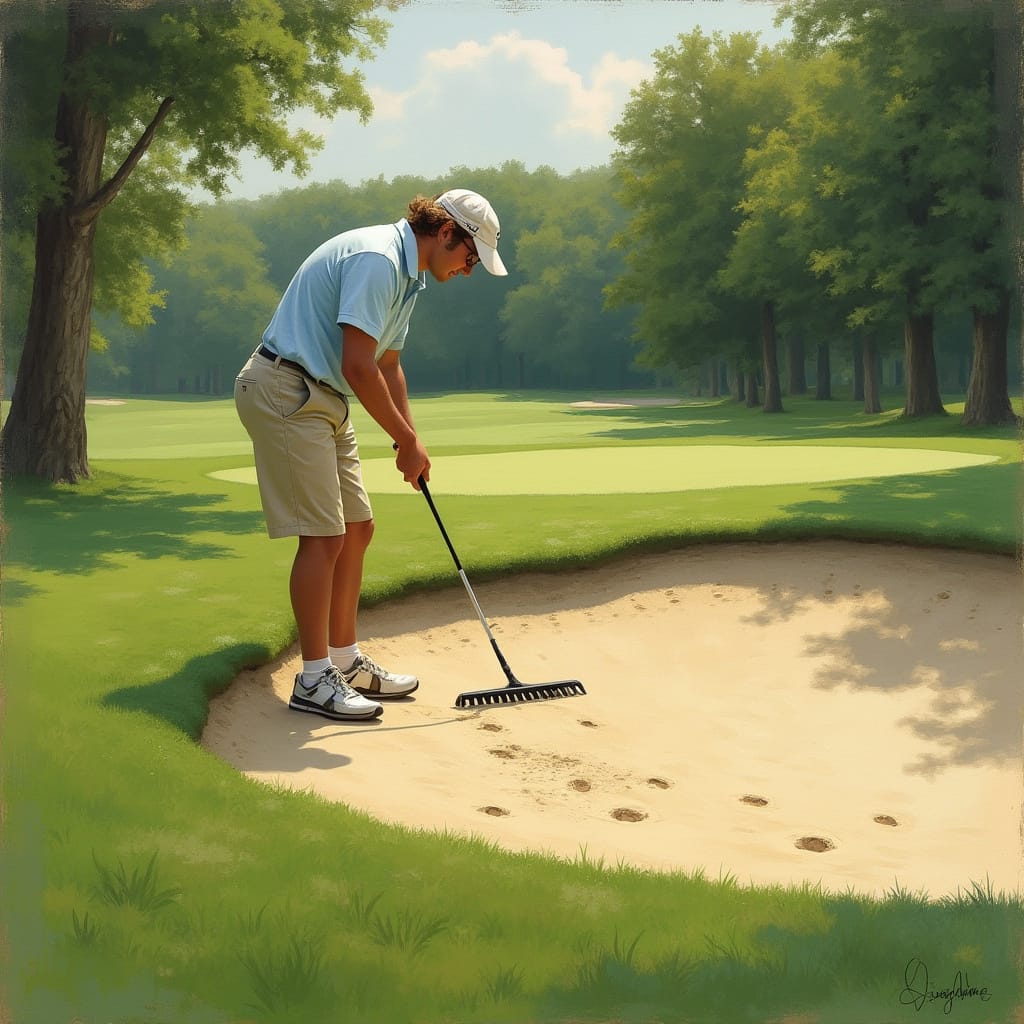Golf Etiquette for Beginners: 9 Must-Know Do’s & Don’ts to Avoid Embarrassing Mistakes

Table of Contents
Key Takeaways
- By being a good golf etiquette ambassador, you help make the course enjoyable for every golfer and earn respect from your fellow players in return.
- Keep things moving and stay prepared to play when it’s your turn. Let faster groups play through and you’ll help everyone enjoy the game!
- Be considerate of the course, fix ball marks, rake bunkers, replace divots, and be respectful of wildlife and any maintenance taking place.
- Be clear and respectful with your playing partners and course staff, and understand when in-round conversation should be muted.
- Obey all golf cart regulations, park carefully, and limit phone and music usage to keep yourself and others safe and help you maintain focus.
- Arriving early, understanding dress codes, and learning essential etiquette rules will set you up for a confident and successful golf outing.
Etiquette is simply a set of rules and good habits. Following these rules will ensure that inexperienced players will seamlessly blend in and play efficiently on any golf course across the United States.
Caring about other people and the place they are playing, including good etiquette and consideration for other players, play as big a role as their swing or score. Here’s some golf etiquette for beginners so you understand when to be silent, where to stand and how to maintain course speed.
Repairing ball marks, raking bunkers and observing dress codes further enhances the game for all. Understanding these fundamentals allows new players to have fun and play confidently without any uncomfortable situations.
This guide touches on the most important concepts, etiquette, tips, and lived experience for beginners. Looking to level up your gaming experience today?
Why Golf Manners Matter More Than Score
Golf is about much more than the score on your scorecard. Proper etiquette sets the tone for the entire experience—even just one person on the course. Respecting golf etiquette makes the game more enjoyable for all.
It improves every round for everyone, no matter what their skill level or background. These practices are a demonstration of courtesy to fellow players, the golf course, and the game’s time-honored history. For beginners, this creates a deeper connection to the game, and to other golfers.

Enhancing Everyone's Game Day
Simple acts—like keeping quiet when someone takes a shot or saying “nice shot” when a buddy sinks a long putt—lift the mood on the course. An encouraging word or a friendly nod can make a bad round a better day.
Small teams, as often found in local club tournaments or business outings, go farthest when all players are working to help their other teammates. Laughs and quick conversations while walking between holes can ease nerves and make everyone on the course feel like they’re part of the club.
Keeping the Game Moving Smoothly
We know golf is a long game, but playing quickly and with purpose goes a long way. Being ready for your turn, watching your ball, and talking with your group if play slows down—these help everyone finish on time.
Remaining cognizant of the party in front allows the course to remain accessible to everyone. This makes sure that everyone has an enjoyable and equitable experience, particularly on crowded weekends or during charity outings.
Showing Respect for Players and Place
Respecting other players—waiting your turn, adhering to course etiquette, respecting the greens and the environment—demonstrates pride in the game. Repairing divots, raking bunkers, not walking on or over putting lines, and avoiding wildlife are all ways to leave the course better for the next group.
Every round that feels great is one where respect for the course and your fellow players produce a better experience.
My Take: Good Etiquette Builds Confidence
My TakeGood etiquette builds confidence. When you show consideration to your fellow players, they will return the courtesy. This fosters confidence and leaves them feeling like the game is more rewarding.
Golf etiquette goes beyond simply following the rules—it’s an opportunity to develop yourself both as a golfer and an individual.
Mastering On-Course Conduct: Key Actions
On-course conduct Golf etiquette is often misconstrued as a set of simple, unwritten rules. It’s the foundation for an enjoyable round that prioritizes the respect, safety, and enjoyment of all those on the course. For novices, it’s crucial that they acquire these habits from the start to feel confident and safe around other players.
These are the right actions to take because they maintain pace of play and the condition of the course for the next group. Below, we detail the key on-course conduct actions. Each chapter features on-course anecdotes and tips for beginners in a fun and entertaining style!
1. Respect Fellow Golfers' Space

Golf is a sport where concentration is key. When a player is ready to take their shot, no distraction is too small to ruin their focus. Make sure to stand at least a full club length away from the person hitting.
Remain quiet, don’t move around, and don’t shake up your golf bag or play with your tees. If you’re waiting for your turn, move off to the side. It goes without saying that you should never stand directly behind or in the peripheral view of the player!
Never walk or talk during someone’s swing or putt. This consideration goes a long way in creating a peaceful atmosphere that allows everyone to play their very best.
2. Maintain a Brisk Pace Always

Start-to-finish, a round of golf must flow effortlessly. There’s nothing worse than slow play, not only annoying other golfers on course but ruining the outing for your entire group.
The most important thing is to stay with the group ahead of you. Don’t waste other people’s time being indecisive on the tee—know what club you’re going to hit, put your glove on, and have your shot planned.
Prevent excessive practice swings or discussions that consume time. If you don’t know the correct action to take, inform your group that you need a moment. After that, return to the course and keep playing!
Showing up plenty of time before your tee time gives you time to warm up and prepare yourself. That way, you won’t be the one delaying everyone behind you.
3. Let Faster Players Pass You

Occasionally, a different group will be moving through at a much faster rate. If they do, let them play through at the next available tee or green. It’s courteous to wave them through, too!
This is increasingly true on busy days, or at crowded public courses. Allowing faster players to pass ensures everyone’s round flows without excessive wait times or delays.
Accept their gratitude with a gracious bow of the head. Don’t take it personally; this is just an inevitable aspect of golf, not a NASCAR track.
4. Fix Your Ball Marks on Greens

Each time you hit a golf ball to the green it makes an impact of some kind, usually a little dent. Repair them immediately with an effective ball mark repair tool!
Simply pinch the sides in and level the cup area flush. Repair not only your ball mark, but if you see one, fix that one as well. This minor gesture goes a long way in maintaining smooth greens, an equal playing field to all those putting after you.
In fact, courses in the U.S. Commonly have little signs to remind players of this. It’s really the responsibility of every golfer to make sure they work.
5. Smooth Out Bunker Footprints

Bunkers are designed to be a hazard that can trip up any golfer, but they’re much more challenging when riddled with deep footprints. Upon finishing your stroke, pick up the closest rake and level out the sand that you walked in and struck.
Approach it as if you were entering from the back side and work your way back out, making the sand as flat as you can. Avoid hauling the rake across the grass edge, it will create a scarring edge that ruins the bunker contour.
Properly maintaining bunkers not only helps level the playing field, but takes care of every player’s next shot.
6. Avoid Stepping on Putt Lines

The putt line—the surface your ball will travel along to reach the cup—needs to remain pristine. Not only does stepping on it risk making marks or dents, it disrupts the line of the next putt.
Walk around, never across, a player’s line. Be aware of where other balls are, where they might be going, and how to walk in a way that doesn’t disturb their path.
When in doubt, consult your playing partner. This small act of consideration tells them you respect their game just as much as they respect yours.
7. Play ‘Ready Golf' When Appropriate
In friendly or casual rounds, this is more common as many groups play ready golf. That means whoever is ready to play goes first, rather than automatically waiting for the player farthest away.
Ready golf not only speeds up the game, it’s well known in the U.S. As an acceptable practice—especially during non-competitive rounds. Communicate to your group that you’re taking this approach, so everybody is clear on how things will go.
Get your club and ball ready and approach when it’s your turn to play. It makes for a more interesting round and prevents slow play from long waits.
8. Be Courteous to Course Staff
Golf course staff—marshals, groundskeepers, clubhouse employees—do their best to maintain a great course for everyone. A smile or friendly thank you goes a long way.

If a course marshal tells you to do something, do it. Little things, such as waiting for maintenance staff to complete mowing before you play through, go a long way.
Protecting this special bond benefits the entire golf industry and keeps courses enjoyable for everyone.
9. Stay Aware of Your Surroundings
With all the walking and all the dangerous airborne projectiles, golf is inherently a risky sport. Pay attention to where other people are hitting, particularly if you’re near an adjacent fairway or a blind hole location.
In fact, yelling “Fore!” if your shot is going to land near another group is one of the most simple yet important actions you can take. Set strict ground rules for phone use—have it on silent and check it only away from the live action.

If you’re looking for a lost ball, keep it to three minutes. If it’s safe, allow the group behind you to hit up ahead! These practices will go a long way to develop trust and avoid incident or injury.
10. Handle the Flagstick Carefully
The flagstick marks the hole, and careless handling can damage the green or the hole edge. Leave it on the edge of the green, not across the middle, and gently return it when you finish.
Always discuss with your group—some players may prefer the flagstick in, some out. Being considerate of the flagstick demonstrates that you respect the course and everyone else’s experience.
11. Replace Your Divots Properly
Every time your downswing removes a patch of turf—be it on the fairway or the rough—put it back. Replace the piece and tamp it down with your foot or a tee.
Not all courses ask for this; some have a sand bottle or grass seed mix in its place. When in doubt, always look to local signage or inquire with staff.
Repairing divots is an easy habit to get into to help take care of the turf and show your club and fellow golfers some love.
12. Mark Your Golf Ball Clearly
Too many balls are similar in appearance, and a stroke penalty is incurred if a player strikes the wrong ball. Mark yours with a distinct dot, line, or small sticker prior to play.
Mark your golf ball clearly and check it before every shot, and announce your mark to your group during competitive or group play. This simple action helps keep the game fair and flowing.
Before Your Round Even Starts
Preparing for a round of golf goes beyond just picking up your clubs and hitting the links. Those first steps can set the tone for your entire day. A great round starts with some knowledge of the fundamentals and arrival at least 30 minutes early.
Never forget to be courteous to the course and the people that are working it. Newbies can be a bit nervous going into their first round, but proper planning and organization will create the ideal atmosphere and mood.
Arrive with Time to Spare
An early arrival is non-negotiable. As a general rule, arrive 30 minutes early to your tee time at a minimum. This window lets you relax and not feel rushed and be able to deal with check-in at the pro shop without a hiccup.
Aiming to warm up is also crucial. Plan to spend about 45 minutes warming up. Use that extra time to warm up on the range and get into your groove! If you like dining or socializing BEFORE the match, come 90 minutes in advance.
That leaves you with a lot of time on your hands to relax and mingle! Make it a rule to be at the first tee no less than 10 minutes before your start time. The starter is counting on you, and if you’re late the group behind you is going to have to wait.
Understand the Club Dress Code
Each club is different when it comes to dress code. Know your club’s dress code before you arrive. Usually, this means a collared shirt, tailored shorts or slacks, and appropriate golf shoes.
Jeans and sandals are likely to be unacceptable at most U.S. Clubs. If you know what to wear, you can dress appropriately to stay comfortable and respectful to everyone around you.
Check In Politely at Pro Shop
Greet the staff, provide your name and tee time, and inquire about any local rules or special notes. If you project a clear and friendly presence, it will set the stage for everything moving forward.
A simple thank you will go a long way to improve the mood and let the staff know you appreciate their assistance.
Communicating Like a Golf Pro
Effective communication makes each golf experience better. It’s the atmosphere, it’s the vibe, it’s the experience from that first tee shot until the last putt drops. Understanding when to speak and when to hear others out fosters mutual respect and is a key aspect of basic golf etiquette. Respecting your fellow golfers ensures a more enjoyable round for all course users, especially for new golfers, resulting in healthier golfing lives and more enjoyable experiences on the course.
Talking with Your Playing Group
Easygoing banter lightens the mood and builds rapport—always a good thing, particularly if you find yourself in a game with some unfamiliar players. Swapping stories about tough holes or sharing a quick tip shows you care about the group, not just your own score.
Otherwise, it’s courteous to talk quietly as loud conversation can distract someone’s concentration. A heartfelt “nice shot” goes a long way, but don’t try to manufacture compliments. Positive reinforcement following a long drive or long putt goes a long way in lifting spirits and maintaining an optimistic playing group.
When a friend is having a hard time, silence speaks louder than words. A little positive reinforcement goes 10 times farther than the chuckles or complaints.
When to Stay Quiet
One time to stay quiet is when people are taking shots on the course. It’s more than that—don’t fidget, don’t pace back and forth, and don’t stand in their putting line. On the putting green, it’s all about the concentration.
Hold your tongue until swings are completed. These hushed pauses allow each player an opportunity to shine and honor the game’s rich history. It’s useful in locating a lost ball—team up, don’t tattle.
Interacting with Course Marshals
Course marshals help to keep play moving fairly. When they come up, hear them out and ask questions in a courteous manner. Say thank you for directions or assistance provided—it can be a simple interaction that goes a long way in recognizing their hard work.
When you listen to their instructions, you help the entire course stay on schedule. Sure, they need to make sure the rules are enforced, but their real job is to help everyone enjoy their round.
Avoiding Common Beginner Blunders
Golf has its own unique set of rules and courtesies and new players are likely to trip over the fundamentals. Perhaps most importantly, understanding proper course and golf etiquette from the jump ensures every round is enjoyable and fair for all players. Knowing what makes most beginners stumble is the first step to staying out of cringe-inducing territory.
This understanding will definitely help your swagger on the course!
Hitting into the Group Ahead
Perhaps the most egregious beginner blunder is hitting into the group in front of you before it clears. Be especially cautious of your shot length and if the fairway or green is clear. It’s always a good idea to discuss with your troop ahead of time on which holes are blind shots/hills.
When you hurry, you have near misses—or even worse, you strike a person. Always put safety and security first. If your ball ever goes in the direction of another group, shout “Fore!” as loudly and clearly as possible so they can hear.
Walking Through Someone's Line
Respect goes a long way in building trust. Don’t walk on someone else’s putting line. This is the route they want their ball to travel from where it lies to the hole.
Be mindful of other people’s lines and paths of travel, especially on the putting green. Please mark your ball if it’s in someone else’s line. Simple habits such as these go a long way in maintaining the focus and peace during play.
Not Raking Bunkers Correctly
When you play from a bunker, use the rake to cover your footprints and other marks left behind. This good raking will leave no clumps or deep grooves remaining.
Share what you learn and encourage everyone around you to do the same. Properly raked bunkers ensure everyone has a proper chance, and more importantly keep the course looking its best.
Slow Play Habits to Break
Golf is most enjoyable when each playing maintains a good pace. Have your club selected and be prepared to hit the instant it’s your turn. No more practice swings or searching for a ball (three minutes maximum according to the rules).
Holding up the group is not ideal. Quick conversations and short phone calls are acceptable, but don’t delay the party. When you see slow play, engage with your playing partners and do what you can to help the entire course move along in a timely manner.
Golf Cart Rules and Tips
Golf carts are a wonderful privilege and they certainly help everyone get around the course, but they have restrictions. Most courses in the U.S. Post cart guidelines at the clubhouse, on the starter’s sheet, or printed right on the scorecard. These rules protect not only your safety, but the integrity of the golf course for all players.
Be mindful of the rules. Make sure to read all posted signs and consult with the starter if you have any questions. Just remember that certain days or holes may have different rules in place. For instance, maybe it’s “cart path only” during inclement weather to save the grass.
Follow Path Rules Strictly
Always adhere to the rules of the course and stay on the paths. Nearly all courses require you to keep off these paths, taking care not to drive on grass around greens and tees. Off the path driving can create ruts or kill grass, directly impacting the course experience for others.
Discuss with your party any area limitations, and keep each other accountable to obeying clearly marked signs. This ensures the course is always maintained correctly and provides each player a better round.
Keep Carts Off Greens and Tees
Don’t drive or park carts on greens and tee boxes. These areas are fragile and can be disrupted with a single mistake. Park your cart a good distance away—typically 30 feet or more.
Watch where you are going. Consider all angles before driving your cart, especially around trees or bushes, to prevent crashes. Get your playing partners to follow suit. Prohibiting these areas helps ensure a consistent playing surface for everyone.
Park Carts Thoughtfully
Find a place to park that won’t interfere with another group of visitors or impede maintenance workers. Don’t park in high-traffic areas such as pathways or close to the green.
Communicate with your group where to park carts so you can ensure the group knows where to go. Simple things like these make for an enjoyable course experience, allowing for the pace of play to flow and keep everyone safe.
Tech Etiquette: Phones and Music
We know modern life doesn’t just slow down, not even on a golf course. We know that phones and music are prevalent on U.S. Courses. Playing them effectively—and appropriately—demonstrates respect for the game and for other players. That is not the ambience that almost all clubs are looking for.
Your phone etiquette and music etiquette make a huge difference in setting that relaxing, resort-like mood.
Keep Phone Use Minimal
Golf is not only a game of concentration, it is an experience in nature. Answering a call or texting in between rounds can disrupt the flow and distraction of everyone else in the process. Most golfers agree: keep your phone out of sight unless it’s urgent.
No one cares if you need to check a quick message or take an emergency phone call. Just make sure to communicate to your group if you’re anticipating an important one! Discreet use—such as taking a step away to answer with a low volume—indicates mindfulness of others in your vicinity.
Doing so keeps everyone else clued into the round and keeps the entire day much more entertaining.
Music Volume Considerations
A little music can help make an otherwise ordinary day on the course something you’ll always remember. It really is best when it’s in sync with your vibe or it evokes good memories. Not everyone shares that sentiment.
Enter the golfers who like to have some tunes on the course. Some people get distracted or offended if the music goes more than a few feet. The usual rule: if your music is heard beyond five feet, it’s too loud.
Headphones are a courteous and wise option. This not only keeps your tunes private, but it allows everyone else to appreciate the natural quiet.
Music Volume Considerations
Always ask your group if they’re comfortable with music. At the very least, be proactive about turning it down or off if someone requests quiet!
Caring for the Golf Course Itself
If golfers appreciate the game, they will appreciate the course. Good etiquette means acting in ways that keep the grounds healthy, safe, and welcoming—both for today’s round and for future players. Every act, from replacing a divot to treating course employees with courtesy, contributes to maintaining the spectacle and playability of the course.
By actively modeling these behaviors, you do more than just help protect the course. You take the lead on creating the right example for everyone else.
Respecting Wildlife and Nature
Regardless if they’re located in the rolling suburbs or on the city’s edge, most courses are teeming with rabbits, birds, and other burgeoning wildlife. Respect their space, and don’t disturb their nests or burrows. Most sustainability-minded courses do a good job posting signs in areas that are protected—so read and respect these signs, as they’re in place for a reason.

If you see a flock of birds around a wetland, take your time. If you find deer on the fairway, allow them to cross. Further reading can help communicate to your club why being aware of local wildlife is important. Respecting nature keeps the game relaxing and supports conservation.
Proper Trash Disposal Habits
Picking up after yourself and disposing of trash properly is simple common sense and good golf etiquette. Dispose of trash and recyclables in appropriate bins typically located close to tees and greens. If you notice litter during your round, go ahead and pick it up, even if it doesn’t belong to you.
Encourage everyone in your group to get into the habit. Develop a routine of using reusable bottles or containers for food and drink. Each small step taken demonstrates true appreciation of the club and the natural surroundings.
Understanding Course Maintenance Signs
That’s why golf courses make an effort to put up visible signs. If a sign indicates that you need to leave carts on the path, please respect that! This is critical to understand near greens and/or when the 90-degree rule is in use.
Respect closed areas and allow staff to perform their jobs safely. When you see a maintenance area in front, warn your playing companions. Fix a ballmark, rake a bunker, and fill a divot when you’re out there. These practices save resources and ensure that the golf course is healthy and enjoyable for everyone.
Conclusion
Golf may seem laid back on the surface, but at its core it’s based on respect. Be punctual, be honest, silence your phone, and repair your divots. You don’t need expensive equipment or a tour-level swing to belong. It’s not hard, but just show people that you’re concerned about the course and the staff. Whether your ball hooks left or you lose track of how many strokes you’ve taken, courtesy never goes unnoticed. Little things, such as not driving your cart on the greens or repairing a divot, go a long way. Looking to make sure your rounds stay fun and smooth? Keep it simple, learn in the process, and watch each other’s backs out there. Looking to level up your golf etiquette game? Try out these tips on your very next round of golf.
Frequently Asked Questions
What are the most important golf etiquette rules for beginners?
Don’t talk when people are teeing off, fill in your divots, and avoid slow play. Adhering to basic golf etiquette principles and caring for other players and the course is more important than your score.
How early should I arrive before my tee time?
Arriving early before your tee time is essential for proper golf etiquette, allowing ample time to check in, warm up, and be ready when your group is called to the tee.
Can I use my phone on the golf course?
Tip #3 – Always keep your phone on silent mode to maintain proper golf etiquette. So please, don’t be that guy — only use your phone in emergencies or far away from play to ensure good sportsmanship and respect for fellow golfers.
What should I do if I accidentally hit into another group?
If you hit an errant shot during your golf game, always yell ‘Fore!' to alert others. Following this, it is essential golf etiquette to apologize to the group you hit into and allow them to clear the path before hitting another ball.
Is there a dress code for golf courses in the United States?
On the majority of courses, proper golf etiquette includes adhering to dress code standards such as collared shirts and golf shoes, while avoiding denim. Check the course website or call ahead to understand their specific rules.
How should I care for the golf course while playing?
Fill divots, fix pitch marks on greens, and rake sand traps after using them. These basic golf etiquette tips show respect for the course, allowing everyone, including yourself, to enjoy the golf game to the fullest.
What are basic golf cart rules I should follow?
Never drive a cart on the grass around greens and tees to maintain proper golf etiquette. Be courteous and obey posted signage at all times to ensure a positive golf game for everyone.
This article contains affiliate links. If you purchase through them, I may earn a small commission at no extra cost to you. See our Affiliate Disclosure.






